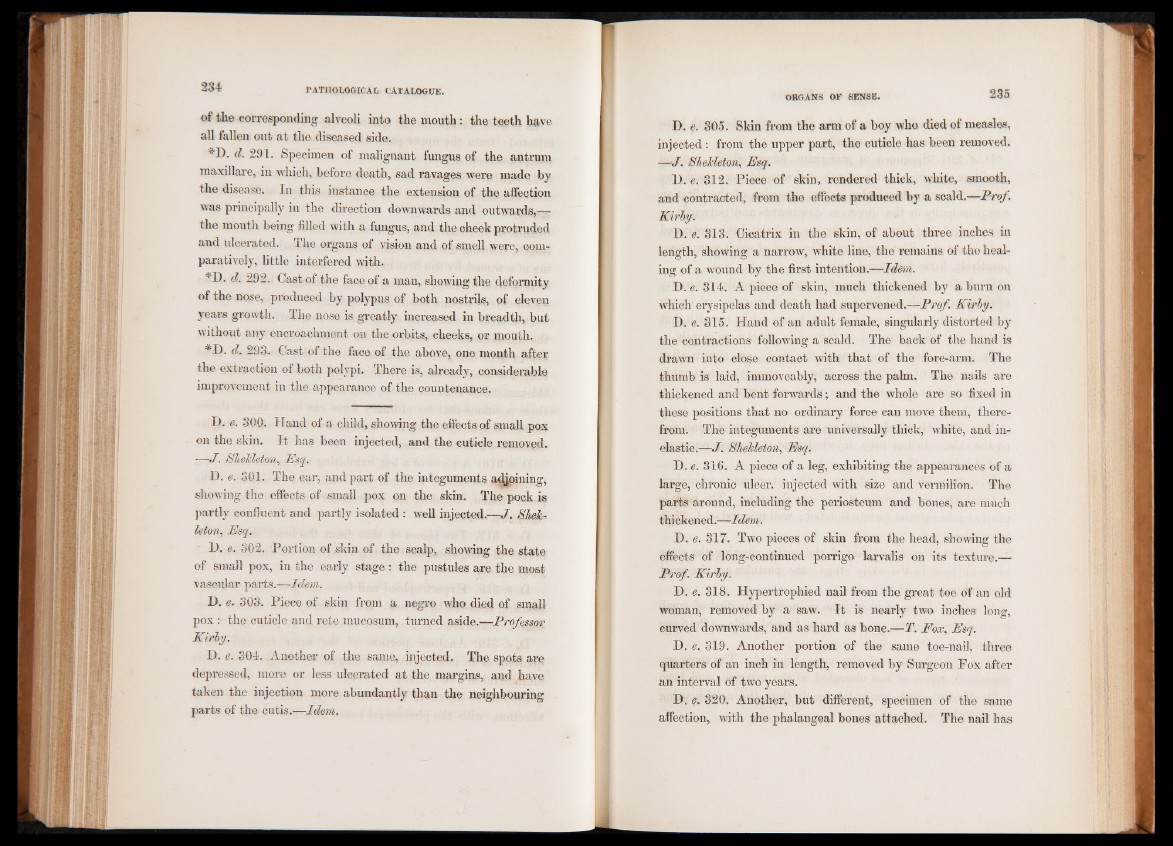
of the corresponding alveoli into the mouth: the teeth have
all fallen out at the diseased side.
*D. d. 291. Specimen of malignant fungus of the antrum
maxillare, in which, before death, sad ravages were made by
the disease. In this instance the extension of the affection
was principally in the direction downwards and outwards,—
the mouth being filled with a fungus, and the cheek protruded
and ulcerated. The organs of vision and of smell were, comparatively,
little interfered with.
*D. d. 292. Oast of the face of a man, showing the deformity
of the nose, produced by polypus of both nostrils, of eleven
years growth. The nose is greatly increased in breadth, but
without any encroachment on the orbits, cheeks, or mouth.
#D. d. 293. Oast of the face of the above, one month after
the extraction of both polypi. There is, already, considerable
improvement in the appearance of the countenance.
D. e. 300. Hand of a child, showing the effects of small pox
on the skin. It has been injected, and the cuticle removed.
■—J. SheJcleton, Esq.
D. e. 301. The ear, and part of the integuments adjoining-,
showing the effects of small pox on the skin. The pock is
partly confluent and partly isolated : well injected.—J. 8hek-
leton, Esq.
1). e. 302. Portion of skin of the scalp, showing the state
of small pox, in the early stage : the pustules are the most
vascular parts.—Idem.
I). e. 303. Pieee of skin from a negro who died of small
pox: the cuticle and rete mu cosum, turned aside.—Professor
Kirby.
B. e. 304. Another of the same, injected. The spots are
depressed, more or less ulcerated at the margins, and have
taken the injection more abundantly than the neighbouring
parts of the cutis.—Idem.
B. e. 305. Skin from the arm of a boy who died of measles,
injected: from the upper part, the cuticle has been removed.
—J. SheJcleton, Esq.
B. e. 312. Piece of skin, rendered thick, white, smooth,
and contracted, from the effects produced by a scald.—Prof.
Kirby.
B. e. 313. Cicatrix in the skin, of about three inches in
length, showing a narrow, white line, the remains of the healing
of a wound by the first intention.—Idem.
B. e. 314. A piece of skin, much thickened by a burn on
which erysipelas and death had supervened.—Prof. Kirby.
B. e. 315. Hand of an adult female, singularly distorted by
the contractions following a scald. The back of the hand is
drawn into close contact with that of the fore-arm. The
thumb is laid, immoveably, across the palm. The nails are
thickened and bent forwards; and the whole are so fixed in
these positions that no ordinary force can move them, therefrom.
The integuments are universally thick, white, and inelastic.—
J . Shelleton, Esq.
B. e. 316. A piece of a leg, exhibiting the appearances of a
large, chronic ulcer, injected with size and vermilion. The
parts around, including the periosteum and bones, are much
thickened.—Idem.
B. e. 317. Two pieces of skin from the head, showing the
effects of long-continued porrigo larvalis on its texture.—
Prof. Kirby.
B. e. 318. Hypertrophied nail from the great toe of an old
woman, removed by a saw. It is nearly two inches long,
curved downwards, and as hard as bone.—T. Fox, Esq.
B. e. 319. Another portion of the same toe-nail, three
quarters of an inch in length, removed by Surgeon Pox after
an interval of two years.
B. e. 320. Another, but different, specimen of the same
affection, with the phalangeal bones attached. The nail has